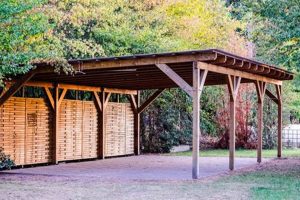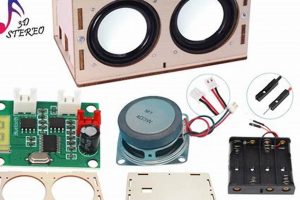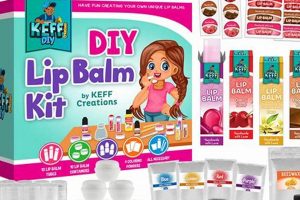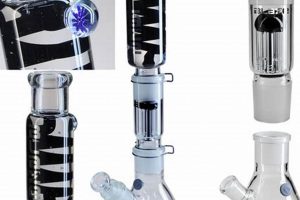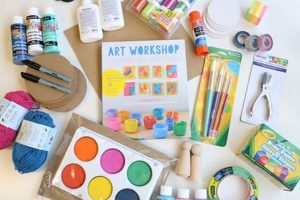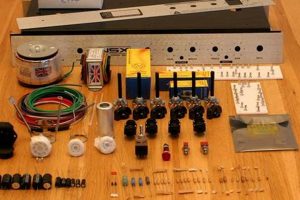A crafting package designed for individual assembly of miniature, enclosed winter scenes within a transparent sphere. These packages typically contain a glass or plastic globe, a base for supporting the globe, decorative figurines, glitter or artificial snow, adhesive, and instructions. The components allow users to create personalized decorative items.
The appeal lies in the opportunity for creative expression and the production of unique, handmade ornaments. The completed product serves as a decorative object, often imbued with sentimental value. Historically, similar novelty items have been popular gifts and keepsakes, representing a tangible expression of personal artistry.
The following sections will detail considerations when selecting a package, explore the variety of available styles, and provide guidance on the assembly process for optimal results and lasting enjoyment.
Essential Guidance for Working with a DIY Snow Globe Package
Successful creation of a miniature winter scene relies on careful planning and precise execution. The following recommendations will help achieve satisfactory results when assembling a snow globe.
Tip 1: Surface Preparation: Ensure the base and figures are clean and dry before applying any adhesive. Residue can inhibit proper bonding, potentially leading to component detachment once the globe is filled with liquid.
Tip 2: Adhesive Selection: Choose a waterproof adhesive specifically designed for use with the materials included in the package. Standard craft glues may dissolve or become cloudy when submerged in water.
Tip 3: Figurine Placement: Arrange the figurines strategically on the base before securing them permanently. Consider the overall aesthetic and ensure sufficient space between objects to allow for adequate snow dispersal.
Tip 4: Distilled Water Usage: Use distilled water to fill the globe. Tap water often contains minerals that can cloud the water over time and potentially discolor the decorative elements.
Tip 5: Glitter or Snow Quantity: Exercise restraint when adding glitter or artificial snow. Overloading the globe can obscure the figurines and diminish the visual impact of the scene.
Tip 6: Sealing Integrity: Carefully seal the base to the globe to prevent leakage. Ensure the seal is watertight and allow ample drying time before handling the finished product.
Tip 7: Air Bubble Management: A small air bubble is normal, but excessive air can detract from the visual appeal. Carefully tilt the globe during assembly to release trapped air before final sealing.
By following these guidelines, individuals can minimize potential complications and maximize the longevity and aesthetic quality of their handmade snow globes.
The subsequent section will delve into the diverse creative possibilities that such projects offer.
1. Component Quality
Component quality directly influences the longevity, aesthetic appeal, and overall success of any snow globe assembled from a do-it-yourself package. Substandard components may compromise the finished product, leading to premature failure or a diminished visual effect.
- Globe Material and Clarity
The globe, typically constructed from glass or plastic, serves as the viewing window for the enclosed scene. Glass offers superior clarity and scratch resistance but is more fragile. Plastic, while more durable, can be prone to scratching and may exhibit lower optical clarity, potentially distorting the interior view. The choice of material directly affects the user’s visual experience of the finished snow globe.
- Figurine Craftsmanship and Material
The figurines included represent the central theme of the snow globe. Their material composition and the precision of their molding determine their resilience to water exposure and potential discoloration. Poorly crafted figures with porous surfaces may absorb water, leading to swelling, cracking, or fading of colors over time. The level of detail and quality of the paint application contribute significantly to the aesthetic value.
- Base Stability and Water Resistance
The base provides the structural foundation and seals the globe, preventing leakage. Its material must be water-resistant to avoid degradation and warping when in constant contact with the internal liquid. A stable, well-constructed base ensures the snow globe remains upright and prevents accidental spills, safeguarding the contained scene.
- Adhesive Formulation and Bond Strength
The adhesive secures the figurines to the base, ensuring they remain firmly in place during handling and display. The adhesive’s formulation must be compatible with the materials being bonded and exhibit resistance to water and potential discoloration. Weak bonding agents can lead to detachment of the figurines, disrupting the snow globe’s intended arrangement and aesthetic.
The selection of a snow globe creation package with high-quality components is paramount. Compromises in material, craftsmanship, or formulation can detract significantly from the final products visual appeal and reduce its lifespan, negating the intended artistic endeavor. Therefore, a careful assessment of component specifications is essential.
2. Adhesive Strength
Adhesive strength constitutes a critical factor in the successful assembly and long-term stability of any snow globe created from a pre-packaged set. Insufficient adhesive strength directly leads to figurine detachment within the liquid medium, disrupting the intended aesthetic and diminishing the artifact’s overall value. The cause-and-effect relationship is demonstrably linear: weaker adhesive results in a higher probability of component failure. The selection of an appropriate bonding agent, therefore, cannot be overstated in its importance.
For example, consider the scenario where a generic craft glue, lacking the necessary waterproof properties, is utilized to secure miniature figures. Upon submersion in water, the adhesive begins to degrade, leading to a gradual weakening of the bond. Eventually, the figures become dislodged, floating freely within the globe and compromising the planned arrangement. This underscores the need for adhesives formulated specifically for submerged environments and capable of forming a durable, water-resistant seal. Furthermore, the surface preparation of the figurines and the base plays a crucial role in maximizing adhesive effectiveness; contaminants and surface irregularities can impede proper bonding.
In conclusion, adequate adhesive strength is not merely a desirable attribute but an essential requirement for snow globe construction. Its role extends beyond simple component attachment, influencing the artifact’s structural integrity and aesthetic preservation. Understanding this relationship allows
users to proactively select appropriate adhesives and employ proper bonding techniques, mitigating the risk of premature failure and ensuring lasting enjoyment of their handcrafted snow globe.
3. Water Clarity
Water clarity is paramount to the visual appeal and longevity of snow globes assembled via do-it-yourself packages. Turbidity, caused by impurities or improper water selection, diminishes the visibility of the enclosed miniature scene. This directly impacts the aesthetic value of the finished product, rendering carefully placed figurines and delicate snow effects less discernible. A clear liquid medium is essential to fully appreciate the craftsmanship and design of the internal components. The selection of distilled water over tap water, for instance, is a crucial determinant of ongoing clarity. Tap water contains minerals and chemicals that can precipitate over time, clouding the liquid and obscuring the scene. The choice of water, therefore, has a profound and lasting effect on the snow globe’s appearance.
The selection of glitter or artificial snow also impacts water clarity. Certain materials may leach dyes or degrade, resulting in discoloration or cloudiness of the water. Similarly, inadequate sealing of the globe can lead to bacterial contamination, which manifests as clouding. For example, introducing organic matter through a compromised seal creates an environment conducive to microbial growth, inevitably affecting water clarity. Addressing cloudiness after assembly poses significant challenges, often requiring complete disassembly and replacement of the liquid medium. This underscores the importance of using appropriate materials and ensuring a hermetic seal during initial construction.
In summary, maintaining water clarity is an integral element in snow globe construction. Clear liquid medium contributes substantially to the visual quality and the overall appreciation of handcrafted miniature scenes. Selection of pure, distilled water, coupled with quality materials and proper sealing methods, mitigates potential cloudiness and ensures lasting clarity within the assembled snow globe.
4. Aesthetic Design
Aesthetic design plays a pivotal role in the creation of snow globes utilizing do-it-yourself packages. The visual harmony and artistic arrangement of internal elements dictate the overall appeal and perceived value of the finished piece.
- Figurine Selection and Thematic Cohesion
The choice of figurines directly impacts the narrative and emotional resonance of the snow globe. Selecting elements that complement a central themesuch as a holiday scene, a landscape, or a character depictionestablishes visual coherence and strengthens the overall aesthetic impact. Disparate or incongruous elements detract from the intended design, resulting in a less compelling visual experience. For instance, including nautical themes in winter scene would clash.
- Arrangement and Compositional Balance
The strategic placement of figurines within the globe influences visual equilibrium and focal points. A balanced composition distributes visual weight evenly, preventing the scene from appearing lopsided or cluttered. Employing principles of perspective and depth enhances the sense of realism and visual interest. Overcrowding or haphazard arrangement diminishes the overall impact. For example, larger figurines are placed on the back and the smaller figures are placed on the front for perspective.
- Color Palette and Harmonious Contrasts
The selection of colors, whether through the figurines themselves or the added glitter/snow, contributes significantly to the overall aesthetic. A cohesive color palette, employing analogous or complementary colors, creates visual harmony. Strategic use of contrasting colors draws attention to specific elements and adds visual depth. Garish or clashing colors detract from the overall aesthetic, creating a disjointed visual experience. White, blues, and greens are often favored for winter themes.
- Snow/Glitter Distribution and Visual Dynamism
The quantity and type of glitter or artificial snow affect the dynamism and visual interest of the snow globe. Controlled distribution mimics the natural fall of snow, creating a sense of movement and realism. Overabundance obscures the figurines, while insufficient amounts fail to create the desired effect. The choice of materialfine glitter, iridescent flakes, or artificial snowalso contributes to the overall visual texture and aesthetic appeal. A fine snow creates a soft feel compared to a bigger sized snow flakes.
The successful integration of these facets of aesthetic design transforms a collection of components into a cohesive and visually appealing art form, highlighting the importance of thoughtful planning and artistic sensibility in the creation of personalized snow globes.
5. Durability
Durability, in the context of a “diy snow globe kit”, signifies the artifact’s capacity to withstand degradation and maintain its structural and aesthetic integrity over an extended period. This attribute directly influences the perceived value and long-term enjoyment derived from the finished product. Compromises in durability translate to a reduced lifespan and diminished visual appeal.
- Material Selection and Resistance to Degradation
The choice of materials for the globe, base, and figurines dictates resistance to chemical and physical degradation. For instance, a globe constructed from low-grade plastic may become brittle and prone to cracking under environmental stress, such as temperature fluctuations. Similarly, figurines crafted from unstable polymers may exhibit discoloration or disintegration when submerged in water for prolonged periods. The inherent properties of the selected materials directly influence the snow globe’s susceptibility to degradation.
- Seal Integrity and Prevention of Leakage
The integrity of the seal between the globe and the base is crucial in preventing water leakage and maintaining the internal environment. A compromised seal allows water to escape, leading to scene degradation and potential damage to surrounding surfaces. Furthermore, a weak seal allows contaminants to enter, fostering bacterial growth and clouding the water, negatively affecting visual clarity and presenting a sanitation risk. Seal failure is one of the most common reasons a snowglobe needs repairs.
- Adhesive Longevity and Component Fixation
The adhesive used to secure figurines to the base must maintain its bonding strength over time, even when continuously immersed in water. Adhesive failure results in figurine detachment, disrupting the intended scene and diminishing the aesthetic value. The selection of a waterproof, non-degrading adhesive is paramount in ensuring long-term component fixation and preserving the structural integrity of the internal arrangement.
- Resistance to UV Exposure and Color Fading
Prolonged exposure to ultraviolet (UV) radiation can cause color fading and material degradation in many snow globe components. Plastic globes may yellow or become brittle, while painted figu
rines may lose their vibrancy. Incorporating UV-resistant materials and finishes mitigates this risk, preserving the aesthetic appeal of the snow globe for an extended duration. Displaying the globe away from direct sunlight prolongs its life.
Collectively, these facets underscore the integral role of durability in the design and construction of a “diy snow globe kit”. Attention to material selection, seal integrity, adhesive longevity, and UV resistance ensures that the finished product can withstand the test of time, providing lasting enjoyment and retaining its aesthetic value.
Frequently Asked Questions About DIY Snow Globe Packages
This section addresses common inquiries regarding the assembly, materials, and expected outcomes when utilizing commercially available snow globe construction sets.
Question 1: What is the expected lifespan of a snow globe assembled from this type of kit?
The lifespan varies significantly depending on component quality and assembly technique. However, assuming proper construction and storage conditions, a snow globe may reasonably be expected to retain its aesthetic appeal for several years. Degradation factors include water clouding, component discoloration, and seal failure.
Question 2: Are the materials included in these kits generally safe for children?
Most packages are designed for adult supervision due to small parts that present a choking hazard. Certain adhesives may contain chemicals that require careful handling. Review the manufacturer’s safety instructions and warnings before commencing assembly, and exercise caution to ensure a safe working environment.
Question 3: What type of water is best suited for filling the snow globe?
Distilled water is the recommended medium. Tap water often contains minerals and impurities that can cause clouding over time. Furthermore, distilled water minimizes the risk of bacterial growth within the sealed environment.
Question 4: What measures can be taken to prevent leakage?
Preventing leakage requires meticulous attention to detail during the sealing process. Ensure the mating surfaces of the globe and base are clean and dry before applying adhesive. Use a waterproof sealant specifically designed for the materials involved, and allow sufficient drying time before handling the finished product.
Question 5: How can clouding of the water be addressed after the snow globe has been assembled?
Addressing clouding after assembly is challenging and often requires disassembly. If clouding occurs, carefully drain the existing water, thoroughly clean the globe and components, and refill with distilled water. Ensure a secure seal during reassembly to prevent recurrence.
Question 6: Is it possible to add additional figurines or decorations to the kit contents?
Adding additional figurines or decorations is feasible, provided the components are compatible with the existing materials and do not introduce contaminants that could compromise water clarity. Ensure the added elements are waterproof and securely attached to the base before sealing the globe.
Adhering to these guidelines mitigates the likelihood of common complications and fosters the creation of durable, aesthetically pleasing snow globes.
The following segment explores advanced techniques for customization and personalization.
DIY Snow Globe Kit
The preceding discussion has explored critical facets of the DIY snow globe kit, ranging from component quality and adhesive strength to water clarity, aesthetic design, and overall durability. Each element contributes significantly to the final product’s success, both in terms of visual appeal and long-term preservation. Understanding these factors enables informed decision-making during material selection and assembly processes.
Mastering these fundamental aspects elevates the snow globe from a simple novelty item to a handcrafted artifact embodying artistic expression and enduring value. The pursuit of quality and precision in its creation secures its place as a cherished keepsake, reflecting dedication and skill for years to come. Further research and experimentation are encouraged to push the boundaries of this traditional craft.


